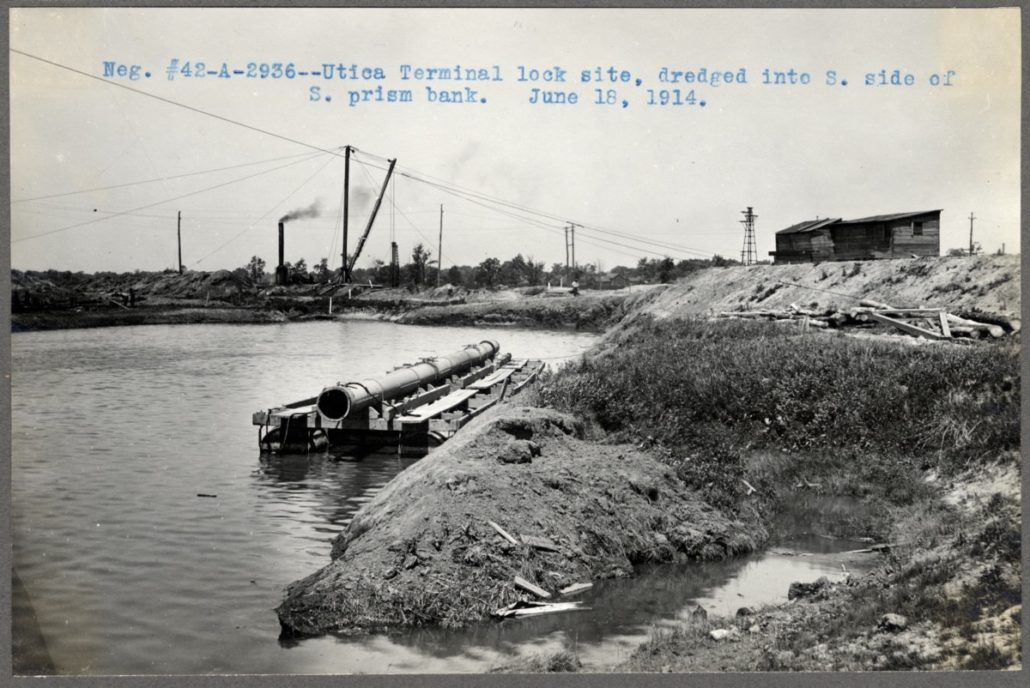This day in Mohawk Valley history: March 20
The Observer, March 20, 1897, Utica, Oneida County, New York
The Big Ditch Flooded
GULF STREAM WORKED UNDER THE BIG BASIN WALL.
Necessary to Stop Work With the Steam Shovels—Night Force to Commence on the Bridge.
The heavy down-pour of rain last night worked serious damage to the contractors on the canal improvement in this section and considerable damage to the Genesee Street bridge contractors. While there was not as large an amount of snow on the hillsides as usual at this time of year there was sufficient rain to cause quite a river to flood down the gulf in East Utica. Where Bleecker, Jay and other streets cross the Gulf culverts six or seven feet high have been built to accommodate the Gulf Stream. These were running nearly full this morning. At the canal the bottom of the Gulf is perhaps fifteen below the top of the retaining wall, and a basin forms commonly known as the “big basin.” The canal contractors built a new wall a this point with a spillway on top and inserted a pipe two feet in diameter near the bottom in the canal. When the water in such quantity as to nearly fill the six-foot culverts cam rushing down the Gulf and against the new wall, the two-foot pipe was of little use in accommodating it, and it boiled and whirled against the bottom of the wall until it began to undermine it.
Men were on guard during the night, but nothing could be done till daylight. By that time the water was running under the wall, standing on a concrete bottom, as well as through the two-foot pipe, and the safety of the wall itself was threatened. Fifty or more men were at once set to work, and during the forenoon bags to the number of some hundreds filled with sand and tightly tied, were thrown into the basin at the bottom of the wall, until the leak was finally stopped or nearly so. In the meantime, the volume of water in the Gulf Stream had diminished about one-half, and the danger to the wall was over for the present.
The water that entered the canal at this point, together with other surface water, filled the big ditch to such an extent that the steam-shovels could not be worked and they stand idle to-day, just east of John street bridge. The water found an outlet at the keystone of the State sewer, a few feet west of John St. bridge. This caused the water to flow west from the Gulf, giving it the appearance of running “up-stream.” The canal railroad track was covered at some points. The contractors were getting along nicely with their work, and this set-back is to be regretted. No work could be done to-day. It has been an exceptionally favorable spring, so far as high water is concerned, in this section, but the Gulf has never yet failed to do its share in the freshet line. If there is anything wrong in the planning of the work on the canal at the Basin, it is well that it was discovered thus early. The total damage so far may be $1,000.
The rain also worked damage to the Genesee street bridge contractors, so far as the masonry work is concerned. Everything was thoroughly soaked this morning, and little could be accomplished to-day. The work of removing the old girders was, however, continued, and also the drawing and unloading of stone for the west side abutments.
It is decided to be impossible to finish the contract, or to get the bridge in proper shape for business, by the opening of navigation with all the men that can be employed working in the daytime only, and beginning Monday night work will be continuous day and night. Arrangements were made to-day for all the electric lights needed. Beginning tomorrow the work will be pushed daily, Sundays included.
The John street bridge was raised last night in anticipation that the steam-shovel would be working underneath it to-day. Work being stopped, however, as stated above, the bridge was lowered again this forenoon. At the north end of the bridge workmen have begun digging for the sewer, which is fifteen feet below the surface.
A new railing has been placed around the lift of the Hotel street bridge and a new floor is being laid over the old one.



![Detroit Publishing Co., Publisher. Erie Canal, Utica, N.Y. [Between 1900 and 1915] Photograph. Retrieved from the Library of Congress, <www.loc.gov/item/2016810887/>. Detroit Publishing Co., Publisher. Erie Canal, Utica, N.Y. [Between 1900 and 1915] Photograph. Retrieved from the Library of Congress, .](https://mohawkvalleymuseums.us/wp-content/uploads/2024/03/IMG_3599.jpeg)
![Detroit Publishing Co., Publisher. Erie Canal & Mohawk Valley, Utica, N.Y. [Between 1900 and 1910] Photograph. Retrieved from the Library of Congress, <www.loc.gov/item/2016810634/>. Detroit Publishing Co., Publisher. Erie Canal & Mohawk Valley, Utica, N.Y. [Between 1900 and 1910] Photograph. Retrieved from the Library of Congress, .](https://mohawkvalleymuseums.us/wp-content/uploads/2024/03/IMG_3600.jpeg)
![Detroit Publishing Co., Publisher. Mohawk Valley cotton mills, Utica, N.Y. [Between 1900 and 1915] Photograph. Retrieved from the Library of Congress, <www.loc.gov/item/2016810901/>. Detroit Publishing Co., Publisher. Mohawk Valley cotton mills, Utica, N.Y. [Between 1900 and 1915] Photograph. Retrieved from the Library of Congress, .](https://mohawkvalleymuseums.us/wp-content/uploads/2024/03/IMG_3601.jpeg)

 The Entrance to Old St. Mary’s Cemetery | Archangel Gabriel with Trumpet in Alcove of Mausoleum
The Entrance to Old St. Mary’s Cemetery | Archangel Gabriel with Trumpet in Alcove of Mausoleum